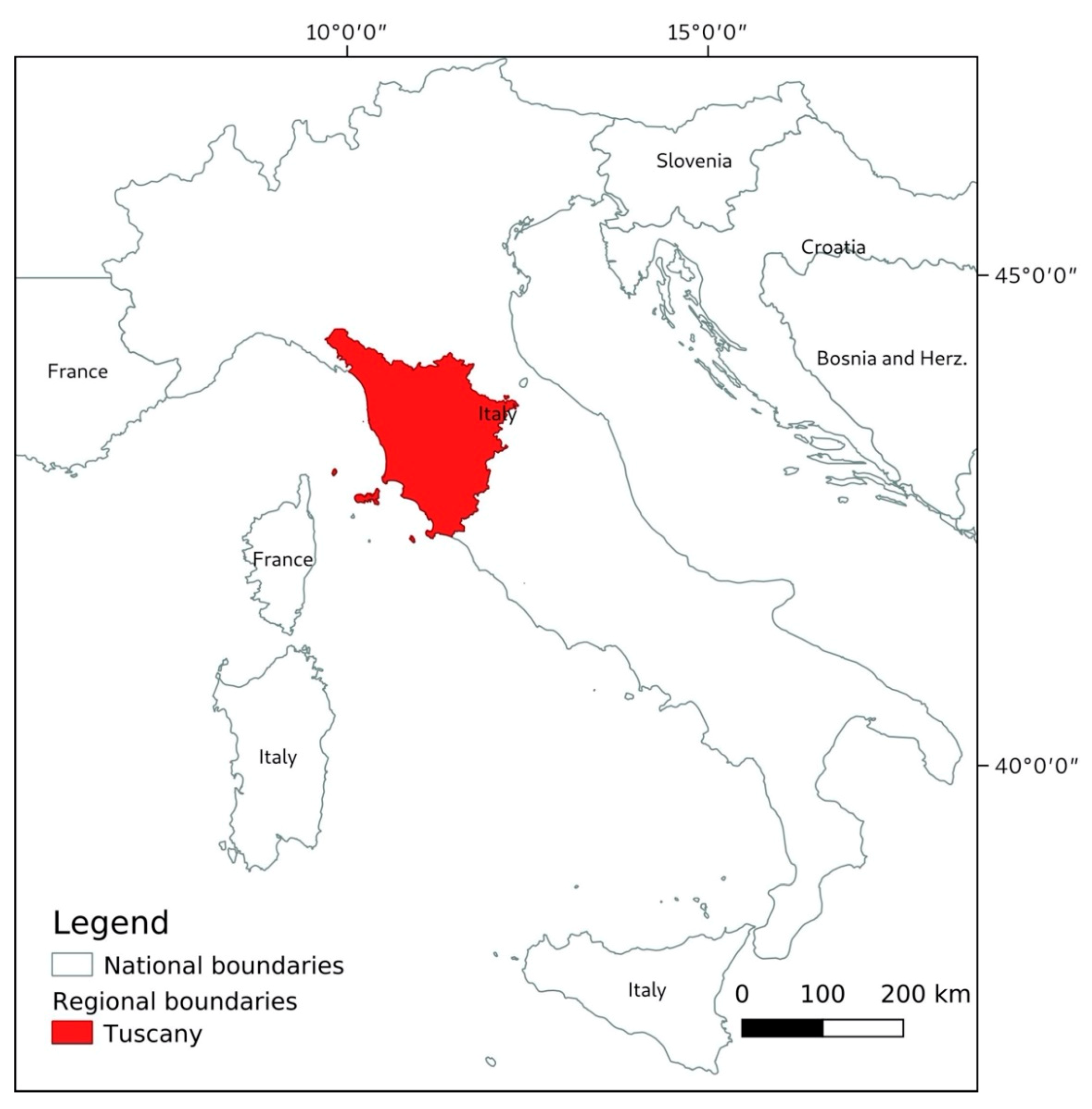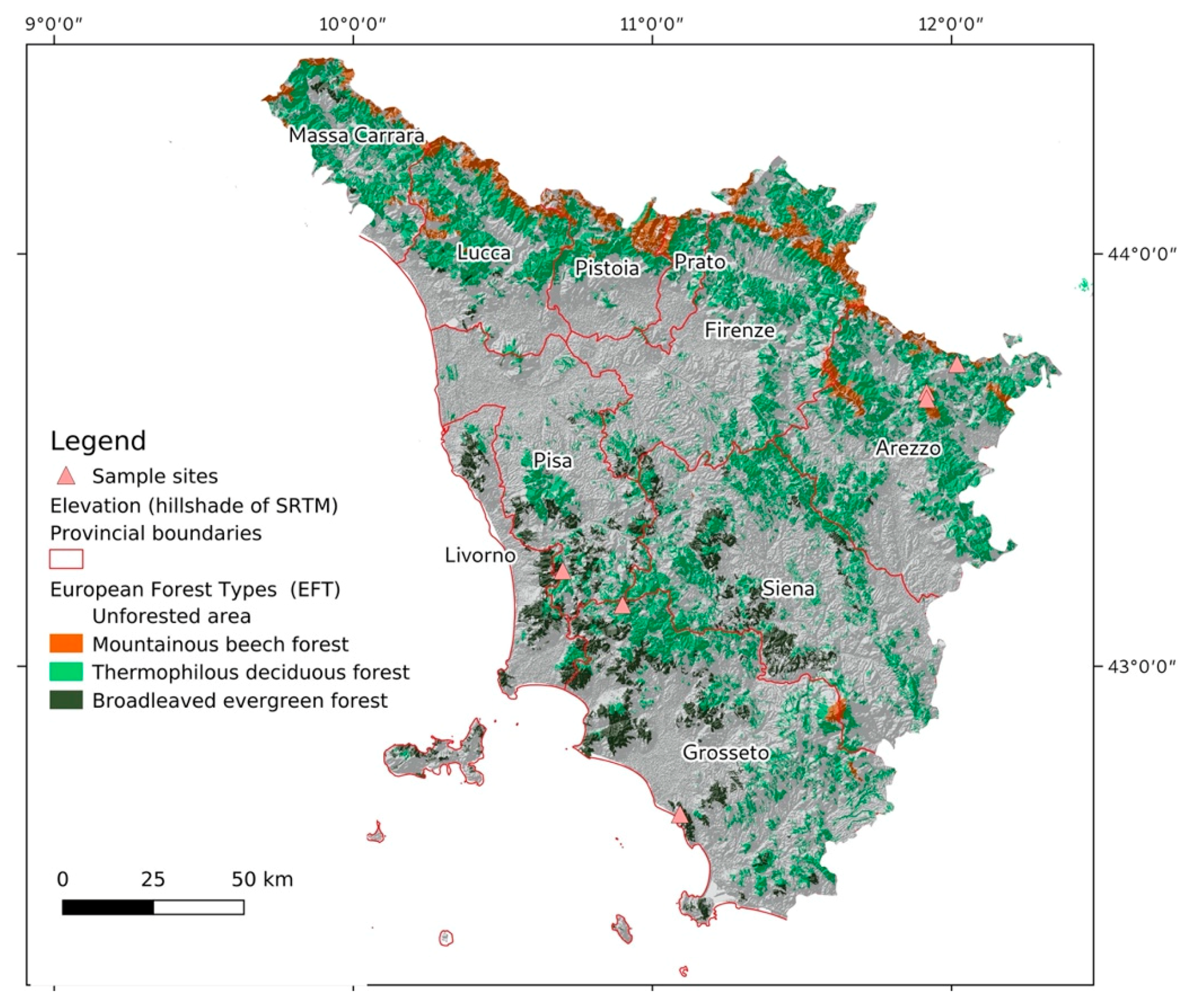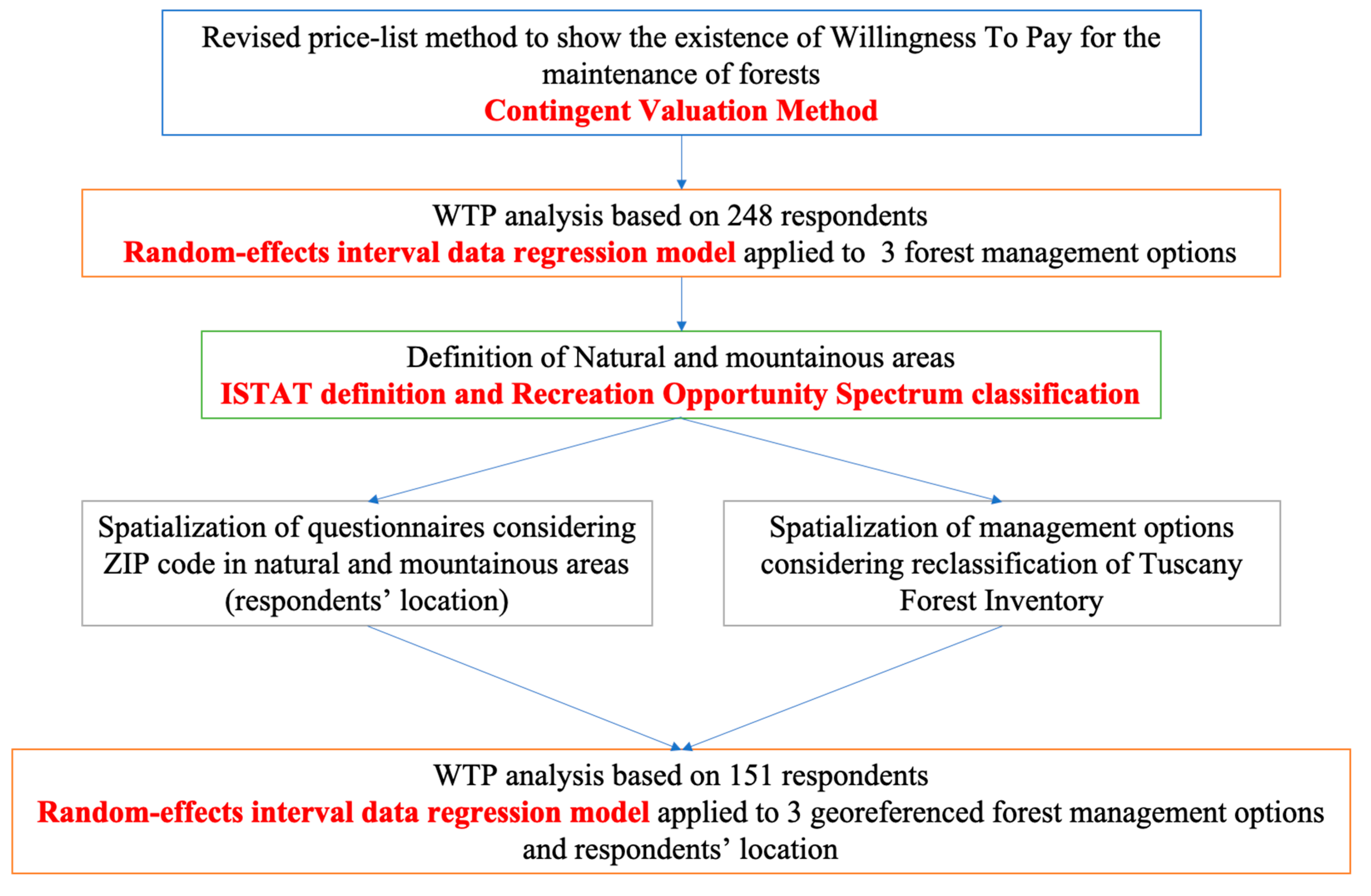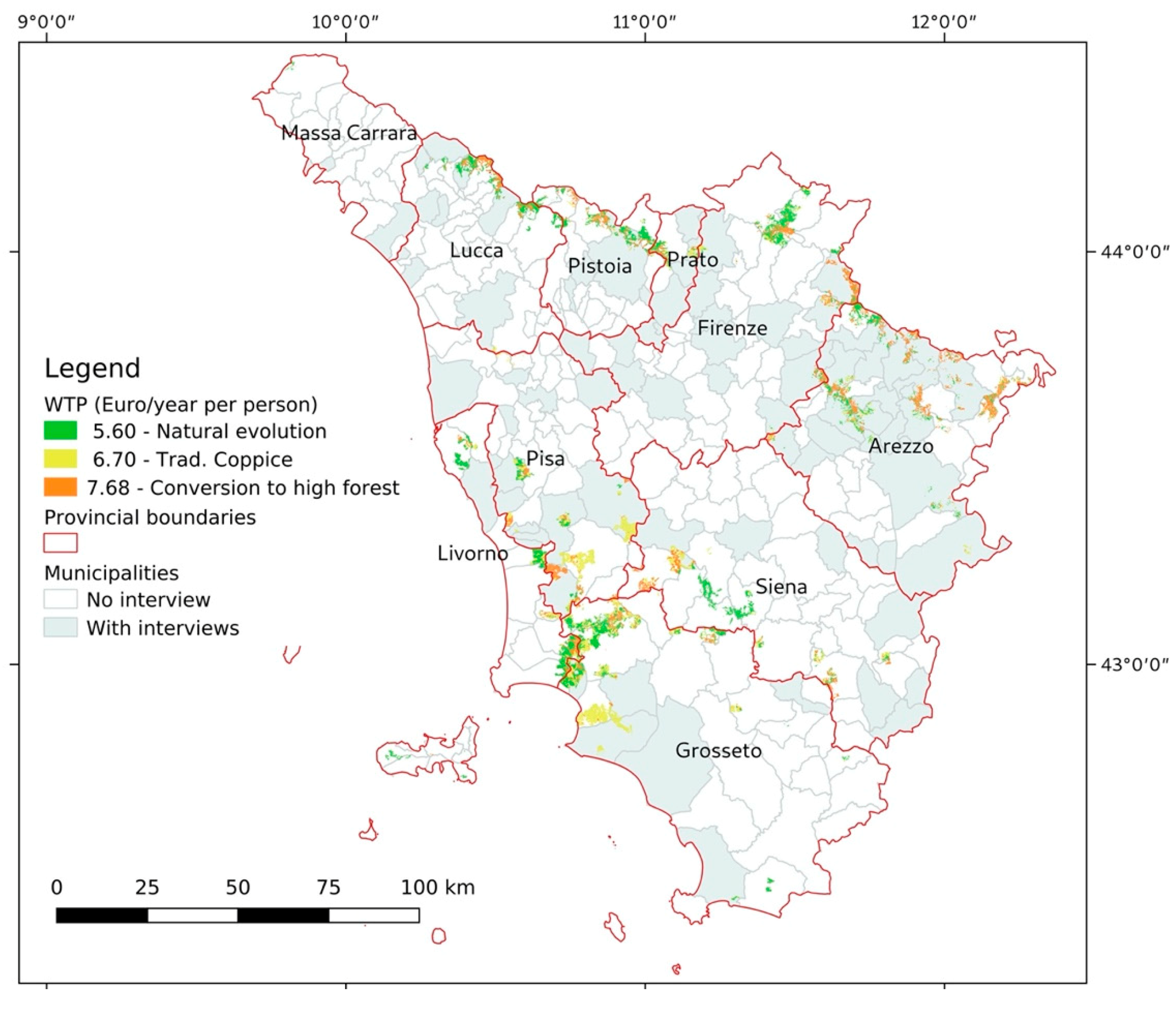Mapping the Recreational Value of Coppices’ Management Systems in Tuscany
Abstract
1. Introduction
2. Materials and Methods
2.1. Case Study
2.2. Evaluation Method for Willingness to Pay
2.3. Identification of Management Options and Spatialization of Data
3. Results
Recreational Value of Forests According to Different Management Options
4. Discussion
5. Conclusions
Supplementary Materials
Author Contributions
Funding
Acknowledgments
Conflicts of Interest
References
- Kubiszewski, I.; Costanza, R.; Anderson, S.; Sutton, P. The future value of ecosystem services: Global scenarios and national implications. Ecosyst. Serv. 2017, 26, 289–301. [Google Scholar] [CrossRef]
- Costanza, R.; D’Arge, R.; De Groot, R.; Farber, S.; Grasso, M.; Hannon, B.; Limburg, K.; Naeem, S.; O’Neill, R.V.; Paruelo, J.; et al. The value of the world’s ecosystem services and natural capital. Nature 1997, 387, 253–260. [Google Scholar] [CrossRef]
- Costanza, R.; de Groot, R.; Braat, L.; Kubiszewski, I.; Fioramonti, L.; Sutton, P.; Farber, S.; Grasso, M. Twenty years of ecosystem services: How far have we come and how far do we still need to go? Ecosyst. Serv. 2017, 28, 1–16. [Google Scholar] [CrossRef]
- Costanza, R. Valuing natural capital and ecosystem services toward the goals of efficiency, fairness, and sustainability. Ecosyst. Serv. 2020, 43, 101096. [Google Scholar] [CrossRef]
- Pearce, D.; Turner, K.; Bateman, I. Economia Ambientale; Mulino: Bologna, Italy, 2003. [Google Scholar]
- Ciccarese, L.; Mattsson, A.; Pettenella, D. Ecosystem services from forest restoration: Thinking ahead. New For. 2012, 43, 543–560. [Google Scholar] [CrossRef]
- Stanturf, J.A. Future landscapes: Opportunities and challenges. New For. 2015, 46, 615–644. [Google Scholar] [CrossRef]
- Bottalico, F.; Pesola, L.; Vizzarri, M.; Antonello, L.; Barbati, A.; Chirici, G.; Corona, P.; Cullotta, S.; Garfì, V.; Giannico, V.; et al. Modeling the influence of alternative forest management scenarios on wood production and carbon storage: A case study in the Mediterranean region. Environ. Res. 2016, 144, 72–87. [Google Scholar] [CrossRef]
- Blattert, C.; Lemm, R.; Thees, O.; Lexer, M.J.; Hanewinkel, M. Management of ecosystem services in mountain forests: Review of indicators and value functions for model based multi-criteria decision analysis. Ecol. Indic. 2017, 79, 391–409. [Google Scholar] [CrossRef]
- Viccaro, M.; Cozzi, M.; Fanelli, L.; Romano, S. Spatial modelling approach to evaluate the economic impacts of climate change on forests at a local scale. Ecol. Indic. 2019, 106, 105523. [Google Scholar] [CrossRef]
- Mahieu, P.A.; Riera, P.; Giergiczny, M. Determinants of willingness-to-pay for water pollution abatement: A point and interval data payment card application. J. Environ. Manag. 2012, 108, 49–53. [Google Scholar] [CrossRef]
- Tao, Z.; Yan, H.; Zhan, J. Economic Valuation of Forest Ecosystem Services in Heshui Watershed using Contingent Valuation Method. Procedia Environ. Sci. 2012, 13, 2445–2450. [Google Scholar] [CrossRef]
- Backéus, S.; Wikström, P. Modeling Carbon Sequestration and Timber Production in a Regional Case Study. Silva Fenn. 2006, 40, 619–629. [Google Scholar] [CrossRef]
- Viccaro, M.; Cozzi, M.; Caniani, D.; Masi, S.; Mancini, I.; Caivano, M.; Romano, S.; Viccaro, M.; Cozzi, M.; Caniani, D.; et al. Wastewater Reuse: An Economic Perspective to Identify Suitable Areas for Poplar Vegetation Filter Systems for Energy Production. Sustainability 2017, 9, 2161. [Google Scholar] [CrossRef]
- Cozzi, M.; Viccaro, M.; Di Napoli, F.; Fagarazzi, C.; Tirinnanzi, A.; Romano, S. A spatial analysis model to assess the feasibility of short rotation forestry fertigated with urban wastewater: Basilicata region case study. Agric. Water Manag. 2015, 159, 185–196. [Google Scholar] [CrossRef]
- Viccaro, M.; Caniani, D. Forest, Agriculture, and Environmental Protection as Path to Sustainable Development. Nat. Resour. Res. 2019, 28, 1–4. [Google Scholar] [CrossRef]
- Vallecillo, S.; La Notte, A.; Zulian, G.; Ferrini, S.; Maes, J. Ecosystem services accounts: Valuing the actual flow of nature-based recreation from ecosystems to people. Ecol. Modell. 2019, 392, 196–211. [Google Scholar] [CrossRef]
- Forest Europe State of Europe’s Forests. 2015. Available online: http://foresteurope.org/state-europes-forests-2015-report (accessed on 7 December 2018).
- Loomis, J.B. Updated Outdoor Recreation Use Values on National Forests and Other Public Lands; U.S. Department of Agriculture, Forest Service, Pacific Northwest Research Station: Corvallis, OR, USA, 2005.
- Zandersen, M.; Tol, R.S.J. A meta-analysis of forest recreation values in Europe. J. For. Econ. 2009, 15, 109–130. [Google Scholar] [CrossRef]
- Voces González, R.; Díaz Balteiro, L.; López-Peredo Martínez, E. Spatial valuation of recreation activities in forest systems: Application to province of Segovia (Spain). For. Syst. 2010, 19, 36. [Google Scholar] [CrossRef]
- Baerenklau, K.A.; González-Cabán, A.; Paez, C.; Chavez, E. Spatial allocation of forest recreation value. J. For. Econ. 2010, 16, 113–126. [Google Scholar] [CrossRef]
- Bishop, R.C.; Romano, D. Environmental Resource Valuation; Studies in Risk and Uncertainty; Springer: Boston, MA, USA, 1998; Volume 11, ISBN 978-1-4613-7630-9. [Google Scholar]
- Sgroi, F.; Foderà, M.; Dana, L.P.; Mangiapane, G.; Tudisca, S.; Di Trapani, A.M.; Testa, R. Evaluation of payment for ecosystem services in Mediterranean forest: An empirical survey. Ecol. Eng. 2016, 90, 399–404. [Google Scholar] [CrossRef]
- Barroso, F.L.; Pinto-Correia, T.; Ramos, I.L.; Surová, D.; Menezes, H. Dealing with landscape fuzziness in user preference studies: Photo-based questionnaires in the Mediterranean context. Landsc. Urban Plan. 2012, 104, 329–342. [Google Scholar] [CrossRef]
- Van der Horst, D. Spatial cost–benefit thinking in multi-functional forestry; towards a framework for spatial targeting of policy interventions. Ecol. Econ. 2006, 59, 171–180. [Google Scholar] [CrossRef]
- Egarter Vigl, L.; Tasser, E.; Schirpke, U.; Tappeiner, U. Using land use/land cover trajectories to uncover ecosystem service patterns across the Alps. Reg. Environ. Chang. 2017, 17, 2237–2250. [Google Scholar] [CrossRef] [PubMed]
- Schirpke, U.; Meisch, C.; Tappeiner, U. Symbolic species as a cultural ecosystem service in the European Alps: Insights and open issues. Landsc. Ecol. 2018, 33, 711–730. [Google Scholar] [CrossRef]
- Schirpke, U.; Scolozzi, R.; De Marco, C.; Tappeiner, U. Mapping beneficiaries of ecosystem services flows from Natura 2000 sites. Ecosyst. Serv. 2014, 9, 170–179. [Google Scholar] [CrossRef]
- Häyhä, T.; Franzese, P.P.; Paletto, A.; Fath, B.D. Assessing, valuing, and mapping ecosystem services in Alpine forests. Ecosyst. Serv. 2015, 14, 12–23. [Google Scholar] [CrossRef]
- Grilli, G.; Paletto, A.; De Meo, I. Economic valuation of forest recreation in an alpine valley. Balt. For. 2014, 20, 167–175. [Google Scholar]
- Cantiani, M.; Geitner, C.; Haida, C.; Maino, F.; Tattoni, C.; Vettorato, D.; Ciolli, M. Balancing Economic Development and Environmental Conservation for a New Governance of Alpine Areas. Sustainability 2016, 8, 802. [Google Scholar] [CrossRef]
- De Meo, I.; Paletto, A.; Cantiani, M.G. The attractiveness of forests: Preferences and perceptions in a mountain community in Italy. Ann. For. Res. 2015, 58, 145–156. [Google Scholar] [CrossRef]
- Behr, D.M.; Ozgul, A.; Cozzi, G. Combining human acceptance and habitat suitability in a unified socio-ecological suitability model: A case study of the wolf in Switzerland. J. Appl. Ecol. 2017, 54, 1919–1929. [Google Scholar] [CrossRef]
- Riccioli, F.; Marone, E.; Boncinelli, F.; Tattoni, C.; Rocchini, D.; Fratini, R. The recreational value of forests under different management systems. New For. 2019, 50, 345–360. [Google Scholar] [CrossRef]
- IFNC. Third National Forest Inventory, 2015. Inventario Nazionale delle Foreste e dei Serbatoi Forestali di Carbonio. Ministero delle Politiche Agricole Alimentari e Forestali, Ispettorato Generale-Corpo Forestale dello Stato. Consiglio per la Ricerca e Speri; Ministero delle Politiche Agricole, Alimentari e Forestali: Rome, Italy, 2015.
- Unrau, A.; Becker, G.; Spinelli, R.; Lazdina, D.; Magagnotti, N.; Nicolescu, V.; Buckley, P.; Bartlett, D.; Kofman, P.D. Coppice Forests in Europe; University Freiburg: Freiburg im Breisgau, Germany, 2018; ISBN 9783981734027. [Google Scholar]
- Green, C.H.; Tunstall, S.M. The evaluation of river water quality improvements by the contingent valuation method. Appl. Econ. 1991, 23, 1135–1146. [Google Scholar] [CrossRef]
- Rodríguez, E.; Lacaze, V.; Lupín, B. Contingent Valuation of Consumers’ Willingness-to-Pay for Organic Food in Argentina. AgEcon Search 2008. [Google Scholar] [CrossRef]
- Wertenbroch, K.; Skiera, B. Measuring Consumers’ Willingness to Pay at the Point of Purchase. J. Mark. Res. 2002, 39, 228–241. [Google Scholar] [CrossRef]
- Tyrväinen, L.; Mäntymaa, E.; Juutinen, A.; Kurttila, M.; Ovaskainen, V. Private landowners’ preferences for trading forest landscape and recreational values: A choice experiment application in Kuusamo, Finland. Land Use Policy 2020, 104478. [Google Scholar] [CrossRef]
- Tuffery, L. The recreational services value of the nearby periurban forest versus the regional forest environment. J. For. Econ. 2017, 28, 33–41. [Google Scholar] [CrossRef]
- Molina, J.R.; Silva, F.R.Y.; Herrera, M.Á. Integrating economic landscape valuation into Mediterranean territorial planning. Environ. Sci. Policy 2016, 56, 120–128. [Google Scholar] [CrossRef]
- González, A.; Ortigoza, E.; Llamosas, C.; Blanco, G.; Amarilla, R. Multi-criteria analysis of economic complexity transition in emerging economies: The case of Paraguay. Socio-Econ. Plan. Sci. 2019, 68, 100617. [Google Scholar] [CrossRef]
- Grima, N.; Singh, S.J.; Smetschka, B. Improving payments for ecosystem services (PES) outcomes through the use of Multi-Criteria Evaluation (MCE) and the software OPTamos. Ecosyst. Serv. 2018, 29, 47–55. [Google Scholar] [CrossRef]
- Voltaire, L.; Donfouet, H.P.P.; Pirrone, C.; Larzillière, A. Respondent Uncertainty and Ordering Effect on Willingness to Pay for Salt Marsh Conservation in the Brest Roadstead (France). Ecol. Econ. 2017, 137, 47–55. [Google Scholar] [CrossRef]
- Kniivilä, M. Users and non-users of conservation areas: Are there differences in WTP, motives and the validity of responses in CVM surveys? Ecol. Econ. 2006, 59, 530–539. [Google Scholar] [CrossRef]
- Venkatachalam, L. The contingent valuation method: A review. Environ. Impact Assess. Rev. 2004, 24, 89–124. [Google Scholar] [CrossRef]
- Boyle, K.J.; Johnson, F.R.; McCollum, D.W.; Desvousges, W.H.; Dunford, R.W.; Hudson, S.P. Valuing Public Goods: Discrete versus Continuous Contingent-Valuation Responses. Land Econ. 1996, 72, 381. [Google Scholar] [CrossRef]
- Alphonce, R.; Alfnes, F.; Sharma, A. Consumer vs. citizen willingness to pay for restaurant food safety. Food Policy 2014, 49, 160–166. [Google Scholar] [CrossRef]
- Andersen, S.; Harrison, G.W.; Lau, M.I.; Rutström, E.E. Elicitation using multiple price list formats. Exp. Econ. 2006, 9, 383–405. [Google Scholar] [CrossRef]
- Cameron, T.A.; James, M.D. Efficient Estimation Methods for “Closed-Ended” Contingent Valuation Surveys. Rev. Econ. Stat. 1987, 69, 269. [Google Scholar] [CrossRef]
- Tian, X.; Yu, X.; Holst, R. Applying the Payment Card Approach to Estimate the WTP for Green Food in China; Publisher ZBW – Leibniz Information Centre for Economics: Kiel, Germany, 2011. [Google Scholar]
- Cameron, A.C.; Trivedi, P.K. Microeconometrics: Methods and Applications; Cambridge University Press: New York, NY, USA, 2005. [Google Scholar]
- Bernetti, I.; Ciampi, C.; Fagarazzi, C.; Sacchelli, S. I comparti forestale e di prima trasformazione del legno. In Stima della Potenzialità Produttiva delle Agrienergie in Toscana; ARSIA: Firenze, Italy, 2009; pp. 43–70. [Google Scholar]
- Sacchelli, S.; Fagarazzi, C.; Bernetti, I. Economic evaluation of forest biomass production in central Italy: A scenario assessment based on spatial analysis tool. Biomass Bioenergy 2013, 53, 1–10. [Google Scholar] [CrossRef]
- Clark, R.N.; Stankey, G.H. The Recreation Opportunity Spectrum: A Framework for Planning, Management, and Research; Gen. Tech. Rep. PNW-GTR-098; U.S. Department of Agriculture, Forest Service, Pacific Northwest Research Station: Portland, OR, USA, 1979; Volume 98, 32p.
- Blocker, L.; Slider, T.; Ruchman, J.; Mosier, J.; Kok, L.; Silbemagle, J.; Beard, J.; Wagner, D.; Brogan, D.; Jones, D.; et al. Landscape Aesthetics (AH 701-l)-Recreation Opportunity Spectrum; U.S. Department of Agriculture (USDA): Washingthon, DC, USA, 1995.
- Perez-Verdin, G.; Lee, M.E. Use of the recreation opportunity spectrum in natural protected area planning and management. In Recreation Visitor Research: Studies of Diversity; Gen. Tech. Rep., PSW-GTR-210; Chavez Deborah, J., Winter Patricia, L., Absher James, D., Eds.; U.S. Department of Agriculture, Forest Service, Pacific Southwest Research Station: Albany, CA, USA, 2008; Chapters 23–28; pp. 23–38. [Google Scholar]
- Riccioli, F.; Pierre, J.; Asmar, E.; El Asmar, T.; El Asmar, J.P.; El Asmar, T. Rete natura 2000 reviewed through territorial GIS Zoning. In Proceedings of the 5th International Conference on Information and Communication Technologies in Agriculture, Food and Environment (HAICTA 2011), Skiathos Island, Greece, 8–11 September 2011; Volume 1152. [Google Scholar]
- Toscana, R. Inventario Forestale Toscano; Regione Toscana: Florence, Italy, 2009. [Google Scholar]
- Brown, K.M.; Taylor, L.O. Do as You Say, Say as You Do: Evidence on Gender Differences in Actual and Stated Contributions to Public Goods. J. Econ. Behav. Organ. 2000, 43, 127–139. [Google Scholar] [CrossRef]
- Burkhard, B.; Maes, J. Mapping Ecosystem Services on Different Scales; Pensoft Publishers: Sofia, Bulgaria, 2017; ISBN 9789546428295. [Google Scholar]
- Logsdon, R.A.; Chaubey, I. A quantitative approach to evaluating ecosystem services. Ecol. Modell. 2013, 257, 57–65. [Google Scholar] [CrossRef]
- Cimini, D.; Portoghesi, L.; Madonna, S.; Grimaldi, S.; Corona, P. Multifactor empirical mapping of the protective function of forests against landslide occurrence: Statistical approaches and a case study. IForest 2016, 9, 383–393. [Google Scholar] [CrossRef]
- Jacobs, S.; Burkhard, B.; Van Daele, T.; Staes, J.; Schneiders, A. “The Matrix Reloaded”: A review of expert knowledge use for mapping ecosystem services. Ecol. Modell. 2015, 295, 21–30. [Google Scholar] [CrossRef]
- Kopperoinen, L.; Luque, S.; Tenerelli, P.; Zulian, G.; Viinikka, A. Introduction Chapter: Mapping cultural ecosystem services. In Mapping Ecosystem Services on Different Scales; Pensoft Publishers: Sofia, Bulgaria, 2017. [Google Scholar]
- Barbati, A.; Marchetti, M.; Chirici, G.; Corona, P. Forest Ecology and Management European Forest Types and Forest Europe SFM indicators: Tools for monitoring progress on forest biodiversity conservation. For. Ecol. Manag. 2014, 321, 145–157. [Google Scholar] [CrossRef]
- Ressurreição, A.; Gibbons, J.; Dentinho, T.P.; Kaiser, M.; Santos, R.S.; Edwards-Jones, G. Economic valuation of species loss in the open sea. Ecol. Econ. 2011, 70, 729–739. [Google Scholar] [CrossRef]
- Berrens, R.P.; Bohara, A.K.; Kerkvliet, J. A Randomized Response Approach to Dichotomous Choice Contingent Valuation. Am. J. Agric. Econ. 1997, 79, 252–266. [Google Scholar] [CrossRef]
- Bord, R.J.; O’Connor, R.E. The Gender Gap in Environmental Attitudes: The Case of Perceived Vulnerability to Risk. Soc. Sci. Q. 1997, 78, 830–840. [Google Scholar]
- Birol, E.; Karousakis, K.; Koundouri, P. Using economic valuation techniques to inform water resources management: A survey and critical appraisal of available techniques and an application. Sci. Total Environ. 2006, 365, 105–122. [Google Scholar] [CrossRef]
- Tempesta, T.; Thiene, M. Percezione e Valore del Paesaggio; Angeli, F., Ed.; Franco: Angeli, Finland, 2006; ISBN 9788846479136. [Google Scholar]
- Pawar, K.V.; Rothkar, R.V. Forest Conservation & Environmental Awareness. Procedia Earth Planet. Sci. 2015, 11, 212–215. [Google Scholar] [CrossRef]
- Tattoni, C.; Ianni, E.; Geneletti, D.; Zatelli, P.; Ciolli, M. Landscape changes, traditional ecological knowledge and future scenarios in the Alps: A holistic ecological approach. Sci. Total Environ. 2017, 579, 27–36. [Google Scholar] [CrossRef]
- Ferretti, F.; Sboarina, C.; Tattoni, C.; Vitti, A.; Zatelli, P.; Geri, F.; Pompei, E.; Ciolli, M.; Ferretti, F.; Sboarina, C.; et al. The 1936 Italian Kingdom Forest Map reviewed: A dataset for landscape and ecological research. Ann. Silvic. Res. 2018, 42, 3–19. [Google Scholar] [CrossRef]
- Hu, W. Comparing consumers’ preferences and willingness to pay for non-GM oil using a contingent valuation approach. Empir. Econ. 2006, 31, 143–150. [Google Scholar] [CrossRef]
- Kula, E. Economics of Natural Resources, the Environment and Policies; Springer: Dordrecht, The Netherlands, 1994. [Google Scholar]
- Azuma, K.; Kagi, N.; Kim, H.; Hayashi, M. Impact of climate and ambient air pollution on the epidemic growth during COVID-19 outbreak in Japan. Environ. Res. 2020, 190, 110042. [Google Scholar] [CrossRef] [PubMed]
- Wang, Q.; Su, M. A preliminary assessment of the impact of COVID-19 on environment—A case study of China. Sci. Total Environ. 2020, 728, 138915. [Google Scholar] [CrossRef] [PubMed]
- Rugani, B.; Caro, D. Impact of COVID-19 outbreak measures of lockdown on the Italian Carbon Footprint. Sci. Total Environ. 2020, 737, 139806. [Google Scholar] [CrossRef] [PubMed]
- Somani, M.; Srivastava, A.N.; Gummadivalli, S.K.; Sharma, A. Indirect implications of COVID-19 towards sustainable environment: An investigation in Indian context. Bioresour. Technol. Rep. 2020, 11, 100491. [Google Scholar] [CrossRef]
- ISTAT Inflazione Per il 2020 in Italia. Analisi e Tabelle con Indici. Available online: https://www.rivaluta.it/inflazione/inflazione-2020.asp (accessed on 16 September 2020).
- Regione Toscana Psr 2014–2020 della Toscana: Misure, Sottomisure e Operazioni-Notizie-Regione Toscana. Available online: http://www.regione.toscana.it/-/psr-2014-2020-della-toscana-misure-sottomisure-e-operazioni (accessed on 20 May 2019).
- Riccioli, F.; Fratini, R.; Marone, E.; Fagarazzi, C.; Calderisi, M.; Brunialti, G. Indicators of sustainable forest management to evaluate the socio-economic functions of coppice in Tuscany, Italy. Socio-Econ. Plan. Sci. 2019, 100732. [Google Scholar] [CrossRef]
- Fabbio, G.; Cutini, A. Coppice today: Which management beyond definitions? For. -Riv. Selvic. Ecol. For. 2017, 14, 257–274. [Google Scholar] [CrossRef]
- Ciccarese, L.; Crosti, R.; Cascone, C.; Cipollaro, S.; Ballarin Denti, A.; Fontanarosa, E.; Masiero, M.; Pizzuto Antinoro, M.; Veca, L.M.D. Status Report of Forest Biomass Use in the Mediterranean Region; Proforbiomed Report; Case-study; ISPRA: Varese, Italy, 2012.
- Machado, A. An index of naturalness. J. Nat. Conserv. 2004, 12, 95–110. [Google Scholar] [CrossRef]
- Lienhoop, N.; MacMillan, D. Valuing wilderness in Iceland: Estimation of WTA and WTP using the market stall approach to contingent valuation. Land Use Policy 2007, 24, 289–295. [Google Scholar] [CrossRef]
- Orsi, F.; Geneletti, D.; Borsdorf, A. Mapping wildness for protected area management: A methodological approach and application to the Dolomites UNESCO World Heritage Site (Italy). Landsc. Urban Plan. 2013, 120, 1–15. [Google Scholar] [CrossRef]
- Carver, S.J.; Fritz, S. Mapping Wilderness; Concepts, Techniques and Applications; Springer: Berlin/Heidelberg, Germany, 2016; pp. 1–204. [Google Scholar] [CrossRef]
- Kelson, A.R. Integrating wilderness within broader landscapes: The U.S. public land experience. Land Use Policy 1998, 15, 181–189. [Google Scholar] [CrossRef]
- Lupp, G.; Höchtl, F.; Wende, W. “Wilderness”—A designation for Central European landscapes? Land Use Policy 2011, 28, 594–603. [Google Scholar] [CrossRef]
- Palonen, T.; Hyyti, H.; Visala, A. Augmented Reality in Forest Machine Cabin. IFAC-PapersOnLine 2017, 50, 5410–5417. [Google Scholar] [CrossRef]
- Sacchelli, S.; Grilli, G.; Capecchi, I.; Bambi, L.; Barbierato, E.; Borghini, T. Neuroscience Application for the Analysis of Cultural Ecosystem Services Related to Stress Relief in Forest. Forests 2020, 11, 190. [Google Scholar] [CrossRef]
- Sacchelli, S.; Favaro, M. A Virtual-Reality and Soundscape-Based Approach for Assessment and Management of Cultural Ecosystem Services in Urban Forest. Forests 2019, 10, 731. [Google Scholar] [CrossRef]
- Mattila, O.; Korhonen, A.; Pöyry, E.; Hauru, K.; Holopainen, J.; Parvinen, P. Restoration in a virtual reality forest environment. Comput. Hum. Behav. 2020, 107, 106295. [Google Scholar] [CrossRef]




| Variable. | Description | Mean | SD | |
|---|---|---|---|---|
| Age | 1 = 18–35 years old; 2 = 36–50; 3 = 51–65; 4 = >65 | 2.02 | 1.01 | |
| Gender | Dummy variable 1 = female; 0 = male | 0.54 | 0.50 | |
| Educational degree | 1 = primary school; 2 = secondary school; 3 = high school; 4 = Master of Science or above | 3.01 | 0.64 | |
| Occupation | 1 = student; 2 = retired; 3 = housekeeper; 4 = employee; 5 = freelance; 6 = unemployed | 3.08 | 1.66 | |
| WTP | Values in the payment card (interval values from 0 to 22 euros per year) | (1) Coppice | 7.44 | 5.13 |
| (2) Conversion to high forest | 8.64 | 5.31 | ||
| (3) Natural evolution | 6.52 | 5.66 | ||
| Euros/year | 0 € | 2 € | 4 € | 6 € | 8 € | 10 € | 12 € | 14 € | 16 € | 18 € | 20 € | 22 € | Total |
| Coppice | 15 | 39 | 38 | 36 | 40 | 26 | 18 | 13 | 11 | 2 | 5 | 5 | 248 |
| Conversion | 5 | 32 | 37 | 34 | 33 | 41 | 13 | 14 | 15 | 12 | 10 | 2 | 248 |
| Nat. Evolution | 49 | 34 | 27 | 44 | 19 | 24 | 18 | 11 | 4 | 8 | 6 | 4 | 248 |
| Variables | Coef. | Std. Err. | t | p > |t| |
|---|---|---|---|---|
| Conversion | 1.23 | 0.20 | 6.06 | 0.000 ** |
| N_evolution | −1.19 | 0.21 | −5.78 | 0.000 ** |
| Constant | 6.37 | 0.30 | 21.48 | 0.000 |
| σu a | 4.08 | 0.25 | 16.60 | 0.000 |
| σe b | 3.84 | 0.16 | 24.63 | 0.000 |
| ρ | 0.53 | 0.04 | ||
| Log likelihood | −1644.28 | |||
| Wald Chi2(10) | 46.70 | |||
| Prob > Chi2 | 0.000 | |||
| Observation | 744 | |||
| Groups | 248 |
| Variables | Coef. | Std. Err. | t | p > |t| |
|---|---|---|---|---|
| Conversion | 0.98 | 0.31 | 3.16 | 0.0020 ** |
| N_evolution | −1.10 | 0.31 | −3.49 | 0.0000 ** |
| Natural*Conversion | −0.68 | 0.94 | −0.72 | 0.4710 |
| Natural*N_evolution | 0.93 | 0.95 | 0.99 | 0.3240 |
| Mountain*Conversion | 1.24 | 0.88 | 1.41 | 0.1580 |
| Mountain*N_evo | −1.84 | 0.88 | −2.09 | 0.0370 * |
| Constant | 6.70 | 0.37 | 18 | 0.0000 |
| σu a | 3.94 | 0.31 | 12.7 | 0.0000 |
| σe b | 3.91 | 0.17 | 22.55 | 0.0000 |
| ρ | 0.50 | 0.05 | ||
| Log likelihood | −1008.54 | |||
| Wald Chi2(10) | 35.58 | |||
| Prob > Chi2 | 0.000 | |||
| Observation | 453 | |||
| Groups | 151 |
© 2020 by the authors. Licensee MDPI, Basel, Switzerland. This article is an open access article distributed under the terms and conditions of the Creative Commons Attribution (CC BY) license (http://creativecommons.org/licenses/by/4.0/).
Share and Cite
Riccioli, F.; Fratini, R.; Fagarazzi, C.; Cozzi, M.; Viccaro, M.; Romano, S.; Rocchini, D.; Espinosa Diaz, S.; Tattoni, C. Mapping the Recreational Value of Coppices’ Management Systems in Tuscany. Sustainability 2020, 12, 8039. https://doi.org/10.3390/su12198039
Riccioli F, Fratini R, Fagarazzi C, Cozzi M, Viccaro M, Romano S, Rocchini D, Espinosa Diaz S, Tattoni C. Mapping the Recreational Value of Coppices’ Management Systems in Tuscany. Sustainability. 2020; 12(19):8039. https://doi.org/10.3390/su12198039
Chicago/Turabian StyleRiccioli, Francesco, Roberto Fratini, Claudio Fagarazzi, Mario Cozzi, Mauro Viccaro, Severino Romano, Duccio Rocchini, Salomon Espinosa Diaz, and Clara Tattoni. 2020. "Mapping the Recreational Value of Coppices’ Management Systems in Tuscany" Sustainability 12, no. 19: 8039. https://doi.org/10.3390/su12198039
APA StyleRiccioli, F., Fratini, R., Fagarazzi, C., Cozzi, M., Viccaro, M., Romano, S., Rocchini, D., Espinosa Diaz, S., & Tattoni, C. (2020). Mapping the Recreational Value of Coppices’ Management Systems in Tuscany. Sustainability, 12(19), 8039. https://doi.org/10.3390/su12198039







